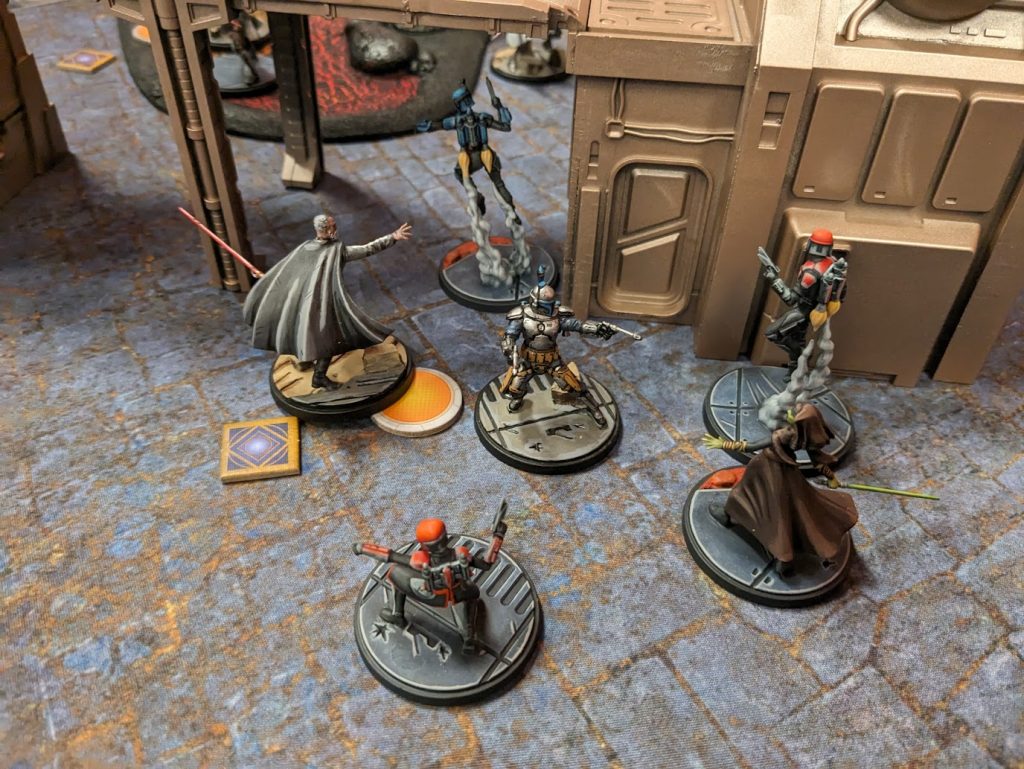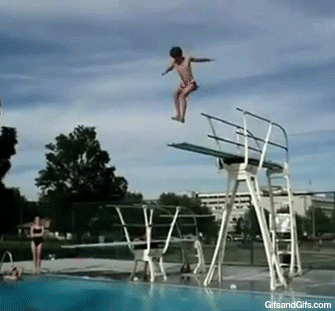
Trending Today

In the past, I’ve gone deep on the first few turns of both Shifting Priorities and Sabotage Showdown. Starting a struggle is very important, but that also means ending a struggle can be critical too. Ideally, you want to end a struggle such that you’re in a strong position to start the next one. It’s difficult to have hard and fast rules for timing the end of a struggle, but today we’ll at least investigate some factors to consider.
Before we begin, I should address the obvious: things can change very quickly in Shatterpoint. If you’re on the front foot, pushing your advantage as much as possible is often the right choice. It doesn’t take much to go from “oh yeah, I should win this pretty easily” to “oh darn, this will be tough to win”. That being said, sometimes it’s a matter of being able to win this turn and spending a lot of resources/taking some risks versus spending less resources/taking less risks and probably winning in a following turn. Sometimes you have to play the long game to give yourself the best chance of winning the game overall.
As I write this article, I’m mainly imagining the following three scenarios, though others may exist.
From the discourse I’ve observed, people are very much aware of the scenario 1, but not so much the others. I’ve seen many posts along the lines of “in my playgroup, the winner of the first struggle always punts on struggle two and wins struggle three easily!” I’m not going to sit here and say that’s not a viable strategy, it’s often the right choice. If you watch my battle reports (and you should) you’ve certainly seen me take that approach. It’s an advantage you get for winning first in a best of three format. However, if your opponent doesn’t care about winning struggle two then you don’t have to try and win it as fast as possible. You have some agency to control when the struggle ends and thus can try to make it happen on your own terms.
So when you’re trying to time the end of a struggle, what are the factors you need to consider? When do you want the struggle to end and when do you want it to go on a little longer? Let’s dive in!

When you start a new struggle, you want to get on the front foot early. A great way to do that is activating units that can have a big impact. Conversely, you want your opponent to activate units that won’t have a big impact.
Obviously, having the Shatterpoint in your draw pile to start a struggle is a great thing. You’ll be able to activate whatever unit is in the best position to make a play. Other than that, you’ll want to activate characters with high swing potential who are fairly mobile or centrally positioned. Units with multiple bodies are also great to draw because they can take a single objective more reliably than a single body unit, or move to contest multiple objectives. I’d usually love to start a struggle where the three cards I have left to draw are the Shatterpoint, Maul, and Clan Kryze, for example.
On the other hand, I don’t want to start a struggle with units that won’t have much impact. Maybe it’s a character who never generates much swing, or they’re way out of position, or they have a pin/disarm/strain that will severely limit their effectiveness. Some units are in the team because they are good during their activation and some are there because they are good out of activation. I generally want an order deck full of the former when I’m about to start a new struggle.
For everything I just said, flip it for your opponent. You want them to have underwhelming draws left in their pile.
As you start a new struggle, you could have a deck loaded with playmakers, but if they don’t have the force available to do their thing then you won’t be happy. Since we’re talking about the mid-game, you may have a decent number of wounded units. Their force needs are going to be different then they were in the early-game. Make sure you’re budgeting enough force so that you can come out guns-blazing in the following struggle. This includes having the option to reserve a card. Due to changing layouts and priority objectives in the second and third struggles, the ability to manipulate the timing of unit activations can be game changing. Spend force if you need to, but make force-efficient plays where possible and be ready to forego some “nice to have” abilities.

There’s also a bit of a push and pull dynamic between force availability and the order deck. The fewer cards in our order deck the more we know about our upcoming activations, but we’ve probably spent a decent amount of force. If we start a struggle on with a fresh deck then it’s a crapshoot as to who will activate next but we have all the force we could want. Neither situation is universally right or wrong, they just have different pros and cons.
In our scenario 1, where you are in struggle two having won struggle one, a main goal for you should be bleeding your opponent’s force. If you can put them in positions where they have to spend a lot of force to avoid losing the struggle then that will put them at a big disadvantage if/when struggle three comes around.
This one is the most “it depends” of all the considerations. You may want to have a lot of enemy units heavily damaged, but not wounded, so that you can finish them off in the new struggle for lots of easy momentum. However, until they’re wounded those units will be able to contest. Against a list with lots of out of activation moves (which most lists should have plenty of) then they could quickly get moved into position and you may not have enough swing to flip those objectives.
A great example of a tough decision would be a MagnaGuard with eight damage. Perhaps if I wound it at the end of the second struggle, the momentum I gain may be inconsequential. However, Separatist lists have about ten billion ways to move Magnas around, so I’m limiting my opponent’s swing potential to start struggle three. Once those Magnas activate again, though, I may need to re-wound them which will be very difficult with ten stamina and good defensive expertise. The right approach will differ game to game, so it’s important to analyze which decision is better in each instance.
I would say I used to be mainly on team leave-them-alive-to-farm-momentum-next-struggle. These days, however, I usually prefer to wound units prior to a new struggle beginning, even if the momentum goes to waste. The main exception would be if the defender in question is about to activate. In that case I’d usually like to let them activate then wound them so that they stay wounded and not contesting for a long time.
Damage and wounds also tie back in to how to evaluate your remaining order deck. It could be great to have Kalani coming up, but maybe not as great if all the supports he moves around are wounded and won’t contest.
Heavily damaged units can be farmed for quick and easy momentum, but until then they get to contest. Wounded units can’t contest, but they do get to pop back up at full health. There are pros and cons in each situation, so you need to try and strike the right balance when setting up for a future struggle.
In the aforementioned Shifting Priorities and Sabotage Showdown articles, I explore objective frequency for each struggle. Depending on the mission and the struggle there are better and worse places to be when the layout is unknown. Beyond that, it’s usually better to be un-wounded and on any objective rather than un-wounded and off of all objectives. You want to start a struggle with units contesting objectives, especially the ones that are more likely to come up. Any objective you can claim turn one of a new struggle (without doing anything) is huge.
Even if it’s Shifting Priorities and your opponent chooses the layout for struggle three, it’s possible to set things up such that neither option is especially attractive. There have certainly been times where my opponent has had to choose, say, losing-losing-uncontested (from their perspective) or losing-tied-uncontested. In Sabotage Showdown, a lucky flip could put you in a great spot because your opponent gets no choice in the matter. To set ourselves up for success, the positioning battle starts in the prior struggles.
For yourself, if you have the first turn in a struggle you ideally want to end up 2-0 or even 3-0 on the objectives. Either will give you a commanding lead in that struggle. There is a bit of luck involved, of course, but you can make your own luck by setting yourself up with good positioning during the prior struggle. I won’t rehash it all here, but not all objectives are created equal. Ideally you should memorize all of the objective layouts and keep them top of mind. That’s a lot of work though, so why not check out my articles that say which spots are most likely to come up? I’ll link them again here for convenience: Shifting Priorities, Sabotage Showdown.

Shatterpoint is played as a best of three. Does this mean the winner of the first struggle has a big advantage? Of course they do, as it should be I would say! And yes, because the winner of the first struggle doesn’t have to win the second struggle, they can afford to sit back and just prepare for the third struggle. But that doesn’t mean the struggle one loser has to only focus on winning struggle two. They have to win it, sure, but if the opponent isn’t pressuring at all then that opens up freedom to take your own time to prepare. You need to win the second struggle, but you also need to win the third struggle, so play with that in mind.
The mid-game is tough to talk about because it’s often very game-state dependent. In one game it you may love to start a new struggle with activations from General Grievous and MagnaGuards, but in the next game those units may not be in a position to make plays. Sometimes you may need to budget four force for the next struggle, but other times two force will be fine. Perhaps wounding a hurt enemy in struggle two is the best play, or maybe you should leave them to be picked off in struggle three.
Due to all these context-dependent decisions, I can’t give many good rules of thumb when it comes to timing the end of a struggle. What I’ve tried to do instead is to highlight some things you want to be aware of and considering as you make decisions. At the end of the day, getting reps is vitality important to learning the mid-game. I have seen some posts about communities where they don’t even play past struggle one because it seems like a forgone conclusion, and that makes me very sad. If you believe and act like it’s a done deal then it will become a self-fulfilling prophecy.
As you get reps, the most important thing is to just make decisions. They don’t need to be the right decisions, you just need to know why you chose to do something. Later, with the benefit of hindsight, you’ll be able to see whether it was the right decision or the wrong decision (which may even be different from whether it worked out or didn’t, remember that it’s possible to make the right decision then get unlucky!) and then that will allow you to reevaluate the process by which you arrived at said decision. Over time, this reflection and tweaking of your evaluation process should lead to sizeable improvements in mid-game play, and potentially some great comeback stories!
Copyright © 2024 The Fifth Trooper. All Rights Reserved.